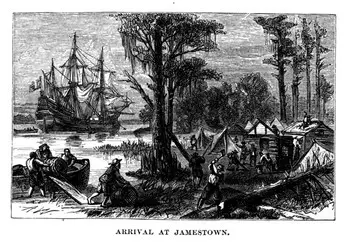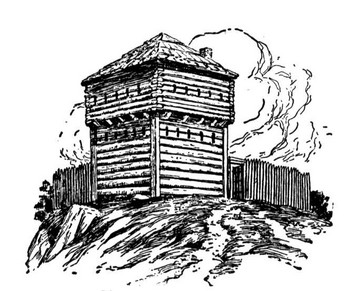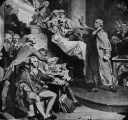In the month of October, all 8th graders will travel to Ottumwa to visit Indian Hills Community College. This event is called "Career Day". You will have the opportunity to see and experience some of the great programs that are offered. In preparation for Career Day, the Counselors will walk you through an interest survey. You will complete it online and it will give us an idea of the types of careers you are interested in.
When the Counselors leave, you may finish the Jamestown Archaeology Google document with your group. If you have finished the Google doc, you may finish the online activities from Tuesday or go to Tween Tribune to read news articles.
The Constitution

The Constitution
Friday, September 30, 2011
Wednesday, September 28, 2011
Jamestown Archaeology
 Today, you will look at some archaeological evidence concerning the economy of Jamestown and the local Native American tribes. Click on the worksheet link below. One member of your group should create a Google document, share it with all group members (don't forget me!), then copy and paste the worksheet to the document for all members to work on.
Today, you will look at some archaeological evidence concerning the economy of Jamestown and the local Native American tribes. Click on the worksheet link below. One member of your group should create a Google document, share it with all group members (don't forget me!), then copy and paste the worksheet to the document for all members to work on.If you finish early, go back to yesterday's blog and finish the two Jamestown games.
Tuesday, September 27, 2011
Jamestown
Today in class, you have two games to play and an article to read.
History Globe: Jamestown Adventure
National Geographic: On the Trail with John Smith
Jamestown: First English Colony in America
Explorers had been landing in America for some time before English settlers arrived in what is now Jamestown, Virginia, in 1607. But it was in that spot on the James River that English colonization began and with it, the history of America.
James I was king of England at that time, and he had granted approval for a group of businesspeople to settle in this new land. They were part of the Virginia Company, and they got the go-ahead in 1606. By December of that year, the expedition was ready.
 In all, 214 people set sail for America. They reached it on May 14, 1607. Very soon after they landed, the English found themselves under attack from Algonquins, a Native American tribe who had been living in that area for some time and who didn't exactly welcome new settlers. The English managed to drive off the attackers, who came back every now and then. The English, however, were there to stay.
In all, 214 people set sail for America. They reached it on May 14, 1607. Very soon after they landed, the English found themselves under attack from Algonquins, a Native American tribe who had been living in that area for some time and who didn't exactly welcome new settlers. The English managed to drive off the attackers, who came back every now and then. The English, however, were there to stay.
 Under the leadership of Captain John Smith, the English built a fort and other buildings designed to protect their new colony. They also found friendly Native Americans, like Powhatan, who was willing to trade with them.
Under the leadership of Captain John Smith, the English built a fort and other buildings designed to protect their new colony. They also found friendly Native Americans, like Powhatan, who was willing to trade with them.
The terrible winter of 1609 convinced most of the settlers to abandon their new life, however. Only 60 of the 214 settlers survived this harsh winter, which was also hard on Powhatan's tribe and other neighboring Native Americans.
(It is this Powhatan, also, whose daughter Pocahontas eventually married John Rolfe.)
 One of the main crops grown by the English settlers was tobacco, which they sold to Native Americans and to people back in England, beginning in 1612. Tobacco became a very popular crop because it was easy to grow and because it brought in so much money.
One of the main crops grown by the English settlers was tobacco, which they sold to Native Americans and to people back in England, beginning in 1612. Tobacco became a very popular crop because it was easy to grow and because it brought in so much money.
Once the money started flowing in regularly, the Jamestown colony grew, as did other settlements in Virginia and in other states along the eastern seaboard.
 America's first elected assembly, the House of Burgesses, met in Jamestown for the first time on July 30, 1619. This group boasted many famous members through the years, including Patrick Henry, George Washington, and Thomas Jefferson.
America's first elected assembly, the House of Burgesses, met in Jamestown for the first time on July 30, 1619. This group boasted many famous members through the years, including Patrick Henry, George Washington, and Thomas Jefferson.
The year 1619 also saw another significant development: the first arrival of black workers on boats from Africa. These men and women were originally indentured servants, who worked a plot of land for a few years and then got to keep the land as owners. (The slave trade didn't get into full swing in this part of America until the 1680s.)
Jamestown was also the capital of Virginia and remained so until 1698.
This article is from a site called "Social Studies for Kids". The article can be found online at http://www.socialstudiesforkids.com/articles/ushistory/jamestown.htmhe
History Globe: Jamestown Adventure
National Geographic: On the Trail with John Smith
Jamestown: First English Colony in America
| ||
James I was king of England at that time, and he had granted approval for a group of businesspeople to settle in this new land. They were part of the Virginia Company, and they got the go-ahead in 1606. By December of that year, the expedition was ready.
 In all, 214 people set sail for America. They reached it on May 14, 1607. Very soon after they landed, the English found themselves under attack from Algonquins, a Native American tribe who had been living in that area for some time and who didn't exactly welcome new settlers. The English managed to drive off the attackers, who came back every now and then. The English, however, were there to stay.
In all, 214 people set sail for America. They reached it on May 14, 1607. Very soon after they landed, the English found themselves under attack from Algonquins, a Native American tribe who had been living in that area for some time and who didn't exactly welcome new settlers. The English managed to drive off the attackers, who came back every now and then. The English, however, were there to stay. Under the leadership of Captain John Smith, the English built a fort and other buildings designed to protect their new colony. They also found friendly Native Americans, like Powhatan, who was willing to trade with them.
Under the leadership of Captain John Smith, the English built a fort and other buildings designed to protect their new colony. They also found friendly Native Americans, like Powhatan, who was willing to trade with them. The terrible winter of 1609 convinced most of the settlers to abandon their new life, however. Only 60 of the 214 settlers survived this harsh winter, which was also hard on Powhatan's tribe and other neighboring Native Americans.
(It is this Powhatan, also, whose daughter Pocahontas eventually married John Rolfe.)
 One of the main crops grown by the English settlers was tobacco, which they sold to Native Americans and to people back in England, beginning in 1612. Tobacco became a very popular crop because it was easy to grow and because it brought in so much money.
One of the main crops grown by the English settlers was tobacco, which they sold to Native Americans and to people back in England, beginning in 1612. Tobacco became a very popular crop because it was easy to grow and because it brought in so much money.Once the money started flowing in regularly, the Jamestown colony grew, as did other settlements in Virginia and in other states along the eastern seaboard.
 America's first elected assembly, the House of Burgesses, met in Jamestown for the first time on July 30, 1619. This group boasted many famous members through the years, including Patrick Henry, George Washington, and Thomas Jefferson.
America's first elected assembly, the House of Burgesses, met in Jamestown for the first time on July 30, 1619. This group boasted many famous members through the years, including Patrick Henry, George Washington, and Thomas Jefferson.The year 1619 also saw another significant development: the first arrival of black workers on boats from Africa. These men and women were originally indentured servants, who worked a plot of land for a few years and then got to keep the land as owners. (The slave trade didn't get into full swing in this part of America until the 1680s.)
Jamestown was also the capital of Virginia and remained so until 1698.
This article is from a site called "Social Studies for Kids". The article can be found online at http://www.socialstudiesforkids.com/articles/ushistory/jamestown.htmhe
Monday, September 26, 2011
The Lost Colony of Roanoke
Read the story of the lost colony
The Lost Colony Quiz
Roanoke Island Hangman
The Lost Colony Quiz
Roanoke Island Hangman
Writing Project: Use a Google doc and share with me!
Choose one of the following theories below about what happened to the Roanoke settlers that you believe best explains what happened to them. Write a paragraph that describes why you think this explanation is the best one.
Choose one of the following theories below about what happened to the Roanoke settlers that you believe best explains what happened to them. Write a paragraph that describes why you think this explanation is the best one.
Theories
1. They left Roanoke Island and went to live with the Native Americans.
2. They left Roanoke Island and went to live in some other place.
2. They left Roanoke Island and went to live in some other place.
3. They made boats out of wood, left Roanoke Island and were lost at sea.
Thursday, September 22, 2011
The Big Test
Today you will have an opportunity to show what you know. The test will cover the Aztec, Maya, and Inca civilizations, as well as the Spanish conquistadors who conquered them.
Click here to take the test!
Click here to take the test!
Wednesday, September 21, 2011
Conquering Mesoamerica

Today we learn of the Spanish Conquistadors who conquered the Aztec and
Inca civilizations. The hand-out received in class is below, as well as a link to the notes taken in class. If you missed class, copy off the hand-out, complete it and turn it in. If you like, you can copy it to a google doc and share with me.
Pizarro and Atalhualpa
Tuesday, September 20, 2011
The Inca Indians
Today we will finish the Mesoamerican "big three".
Having already looked at the Maya and Aztecs, we will focus on the South American Inca civilization.
Click here for Inca notes
Remember to keep good notes. They can be used on the test Friday, and you will hand them in after the test for 5pts.
Having already looked at the Maya and Aztecs, we will focus on the South American Inca civilization.
Click here for Inca notes
Remember to keep good notes. They can be used on the test Friday, and you will hand them in after the test for 5pts.
Monday, September 19, 2011
Exploring North America
Like space explorers in 20th century, European explorers used state of the art technology to travel the ocean.
Today we will begin with Christopher Columbus and by the end of the week we will have studied the New World empire of Spain.
Maya ppt. notes
Aztec ppt. notes
Maya ppt. notes
Aztec ppt. notes
Saturday, September 17, 2011
The Politics of Jobs
 This week we watched a good portion of the September 7th Republican debate, as well as President Obama's speech to promote the American Jobs Act. At this point, you should have a pretty clear picture of Republican economic policy vs. Democratic economic policy.
This week we watched a good portion of the September 7th Republican debate, as well as President Obama's speech to promote the American Jobs Act. At this point, you should have a pretty clear picture of Republican economic policy vs. Democratic economic policy.
We have also learned a few new economic terms:
inflation
scarce
free market
free enterprise
entrepreneur
Now you are ready to take the quiz! Go to the following link:
Good luck! I know you will do well
Friday, September 2, 2011
The Big Story!
At this point, you have researched one Pre-Columbian Native American tribe and have created a poster to represent the geographical, economical, political and social aspects of that tribe.
Now you are ready to write a story about any tribe you like.
Here's how it works:
You are a time traveler. Travel back in time to come in contact with one Pre-Columbian Native American tribe. Remember, you are not writing a report, it's a story! You get to decide what the encounter will be like- good or bad. Include all of the information that you know about that tribe. Use the posters around the room for ideas.
Scoring Guide: Your story should
1) include a Pre-Columbian Native American tribe and a time traveler.
2) include conflict and resolution - remember, it is a story.
3) have specific facts and details about the tribe you chose to write about.
4) be easy to understand- it makes sense.
5) be finished and turned in on time- the beginning of the period Tuesday.
Good luck! I can't wait to read your stories.
Now you are ready to write a story about any tribe you like.
Here's how it works:
You are a time traveler. Travel back in time to come in contact with one Pre-Columbian Native American tribe. Remember, you are not writing a report, it's a story! You get to decide what the encounter will be like- good or bad. Include all of the information that you know about that tribe. Use the posters around the room for ideas.
Scoring Guide: Your story should
1) include a Pre-Columbian Native American tribe and a time traveler.
2) include conflict and resolution - remember, it is a story.
3) have specific facts and details about the tribe you chose to write about.
4) be easy to understand- it makes sense.
5) be finished and turned in on time- the beginning of the period Tuesday.
Good luck! I can't wait to read your stories.
Subscribe to:
Posts (Atom)





